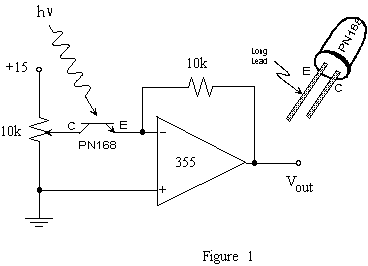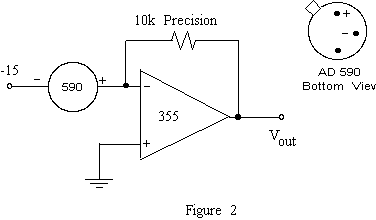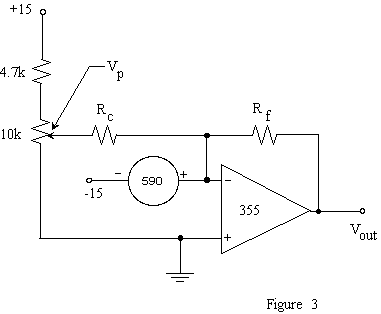
Lab 5: Operational Amplifiers - Part II Current-to-Voltage Amplifiers
In last week's lab, we used operational amplifiers to amplify voltages. In this lab we will experiment with various operational amplifier circuits which convert a current to a voltage. We will use optical and temperature sensors which produce an output current proportional to the incident light intensity or temperature. The sensor current is converted to a low impedance output voltage by means of a current-to-voltage amplifier configuration. In both cases the sensors need a bias voltage across them to operate properly.
A. Optical Detector
1. Construct the optical detector circuit shown in figure 1 using a 355 FET-input amplifier and the PN168 phototransistor. (The 355 more closely approaches an ideal op amp but has the same pin connections as the 741.) Vary the collector voltage VC to determine whether the PN168 acts more like a current source controlled by the incident light or variable resistor whos resistance changes with light.

2. Observe and sketch the output waveform, being sure to note where 0 V d.c. is. Confirm that the output is caused by light incident upon the phototransistor. What is the source of the time varying light incident on your detector? (Hint: Measure its frequency.) Test your hypothesis by disabling the offending light source. Is there still a residual light level? What is its source?
3. The spec sheet for the PN168 says that 500 lux incident light intensity produces 3mA collector current with VC = 8 volts. Use this to estimate the incident light intensity. Compare this with the intensity of direct sunlight (sunlight = 10,000 to 100,000 lux).
B. Temperature Sensor
4. Construct the temperature sensing circuit shown in figure 2 using an Analog Devices Model AD590 Sensor. This is a two-terminal device which behaves as an ideal current source of 1microA/Kelvin over the temperature range -55 to +150 degrees C. Pin connections are as shown.

5. Look at the output on your scope to verify that it is a d.c. level only. Use a battery operated digital multimeter to accurately measure the output d.c. voltage. What room temperature does your reading imply? Compare with the room temperature reading from a thermometer. Check to see how much of the output voltage is due to the amplifier itself by replacing the sensor with a source of zero current.
6. a) What is the sensitivity of the above circuit (Volts/Kelvin)?
b) How could the sensitivity be increased?
c) Approximately how much could the sensitivity be increased without saturating the amplifier output?
7. Greater sensitivity can be obtained using a summing configuration to cancel out the sensor current at room temperature, as shown in figure 3. (What potentiometer voltage Vp would be needed to do this?) Calculate the feedback resistance Rf required to obtain a sensitivity of 0.5Volts/degree C. Construct the circuit and adjust for 0 V d.c. at room temperature. Is Vp what you expected?

8. Check the operation of the above circuit by holding the transducer between your thumb and forefinger. What temperature increase do you register? Normal body temperature is 37 degrees C, and a person with `warm' hands registers about 28-30 degress C. Do you have warm or cold hands? (This will say something about how relaxed you are in doing this lab.) (Or, how cold the room is.)